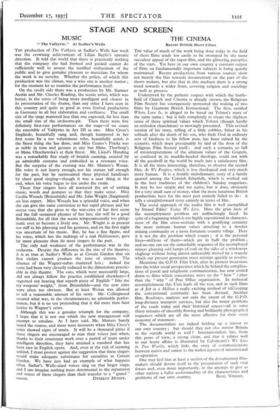THE value of much of the work being done today
in the field of short films tends too easily to be swamped by the more succulent appeal of the super-film, and the glittering panoplies of the stars. Yet here in our own country a constant output of films on fundamentally important subjects is being quietly maintained. Recent productions from various sources show not merely the bias towards documentary on the part of the shorts makers, but also that in this medium there is a strong trend towards a wider front, covering religion and sociology as well as process.
Undeterred by the pathetic corpses with which the battle- field of Church and Cinema is already strewn, the Religious Film Society has courageously sponsored the making of two films by Gaumont British Instructional. The first, entitled Where Love Is, is alleged to be based on Tolstoi's story of the same name ; but it fails completely to create the slightest sense of those spiritual values which Tolstoi (though hardly an orthodox churchman) so movingly presented. This revised version of his story, telling of a little cobbler, bitter in his solitude after the death of his son, who finds God in ordinary acts of kindness to his fellow men, has been ruined by the scenario, which must presumably be laid at the door of the Religious Film Society itself ; and such a scenario, so full of misinterpretations of the ultimate values of the Gospels, so confused in its muddle-headed theology, could not with all the goodwill in the world be made into a satisfactory film. It is all the more interesting, therefore, to observe the second film, As We Forgive, which is less theological and very much more human. It is a frankly melodramatic story of a family quarrel among the Cornish fisherfolk, which is worked out in the best traditions of the children's Sunday magazines. It may be too simple and too naive, but it does, obviously for a very small sum of money, what the more luxurious British productions have for the most part entirely failed to do : it tells a straightforward story entirely in terms of film.
The social approach of the realist film is well exemplified by Strand Films' Today We Live. Here the grim facts of the unemployment problem are unflinchingly faced. In spite of a beginning which is too highly expositional in character, most of the film cross-sections with a gratifying certainty the more intimate human values attaching to a derelict mining community or a more fortunate country village. Here it is not the dry problem which counts ; it is the personal lives—millions of them—which are in bulk the problem ; and no one can see the remarkable sequence of the unemployed miners gleaning odd lumps of coal on the sides of a windswept slagheap without being almost unbearably moved by a tragedy . which our present generation must attempt quickly to resolve.
Meantime the G.P.O. Film Unit, after its pioneer incursions into the wider social perspectives which lie behind the complica- tions of postal and telephonic communication, has now settled down to films which concentrate more on the " how " rather than the " why " of Post Office organisation. In technical accomplishment this Unit leads all the rest, and in such films as A Job in a Million a really exciting method of telescoping the conventional continuity has been devised. Another film, Roadways, analyses not only the extent of the G.P.O. long-distance transport services, but also the major problems of the roads today and their historical causes—all in some thirty minutes of smoothly flowing and brilliantly photographed sequences which are all the more effective for their strict economy of statement. The docuinentalists are indeed holding up a mirror to our own country ; but should they not also mirror Britain to the outside world as well ? Internationalism has, from this point of view, a strong claim, and that it relates well to our home affairs is illustrated by Calvalcanti's We Live in Two Worlds, which links the story of communications between nation and nation to the widest aspects of international co-operation.
One may feel that at least a section of the documentary film- makers should devote itself to the presentation of such vital forces and, even more importantly, to the attempt to give to other nations a fuller understanding of the characteristics and














































 Previous page
Previous page